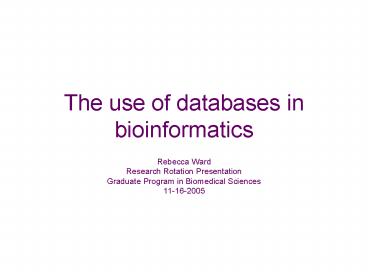The use of databases in bioinformatics PowerPoint PPT Presentation
1 / 32
Title: The use of databases in bioinformatics
1
The use of databases in bioinformatics
- Rebecca Ward
- Research Rotation Presentation
- Graduate Program in Biomedical Sciences
- 11-16-2005
2
Evolution of Biological Information
- Historically, study of overall structures
- In the last 50 years, more molecular in nature
- Molecular Structure
- Molecular Function
3
What is Bioinformatics?
- Organization of biological data for easier
- Searching
- Analysis
- Interpretation
4
Why databases?
- Very complex data is generated
- Need a method of interpreting data for those who
cannot directly analyze it
5
Some Common Databases
- European Molecular Biology Laboratory
- http//www.ebi.ac.uk/Information/
- DNA Database of Japan
- http//www.ddbj.nig.ac.jp/
- Discover http//discover.nci.nih.gov/
- Oncomine 3.0 http//www.oncomine.org/main/in
dex.jsp - Gene Expression Omnibus http//www.ncbi.nlm.ni
h.gov/geo/ - CGAP/SAGE
- http//cgap.nci.nih.gov/
6
EMBL and DDBJ
Collaborative effort with NCBI GenBank
Searchable databases of gene information
7
EMBL
- Gene Expression and Protein Sequences
- UniProt Knowledgebase
- A complete annotated protein sequence database
- Macromolecular Structure Database
- European Project for the management and
distribution of data on macromolecular structures
- ArrayExpress
- Gene expression data
- IntAct
- Provides a freely available, open source database
system and analysis tools for protein interaction
data
8
DDBJ
- Tools to compare nucleic acid sequences and amino
acid sequences - Fasta, blastn, tblastx
- nucleotide nucleotide
- Fastx and blastx
- nucleotide amino acid
- Tfasta, tfastx,blastp, tblastn
- amino acid nucleotide
9
Discover
- Contains various tools for analyzing microarray
data - Has tools for biological literature searches
related specific genes or drugs
10
Discover Tools
- High Throughput GoMiner
- multiple drug treatments
- multiple gene knockouts
- multiple lead compounds for potential drugs
- MedMiner
- Searching of biological literature
- Gene
- Gene gene
- Gene Drug
11
MedMiner
12
(No Transcript)
13
Oncomine
- Allows analysis of gene expression
- Differential Expression data
14
Oncomine
15
Gene Expression Omnibus (GEO)
- Storage of data found in microarray experiments
- Can be searched via
- gene (Gene Profiles)
- study (DataSets)
- GEO accession number
16
How to Use GEO
17
AFAP (GEO)
18
CGAP
19
- Gene Finder
- Anatomical Viewer
- Digital Gene Expression Database
20
CGAP Gene Finder
21
AFAP Gene Info
22
AFAP Expression SAGEAnatomical Viewer
23
SAGE GDED
24
When results are displayed, click on full text to
generate list below
This list can be searched using the Find function
(CtrlF)
25
My Goals in Dr. Guos Lab
- Learn general information about databases
- Generate differential expression data for genes
expressed in normal versus cancerous tissues - Collaboration with Dr. Flynn to determine
differential expression of AFAP
26
Data Generated SAGE
27
MAPK Expression in Breast Cancer
28
AFAP Expression SAGEAnatomical Viewer
29
AFAP Oncomine
30
Quantitative Expression
31
Summary
- Importance of biological databases
- Availability of Databases to Public
- Data generated by database analysis
32
References
- Allen JE, Salzberg SL. JIGSAW integration of
multiple sources of evidence for gene prediction.
Bioinformatics 21(18) 2005. - Barrett T, Suzek TO, Troup DB, Wilhite SE, Ngau
WC, Ledoux P, Rudnev D, Lash AE, Fujibchi W,
Edgar R. NCBI GEO mining millions of expression
profiles-database and tools. Nucleic Acids
Research 33, 2005. - Beerenwinkel N, Sing T, Lengauar T, Rahnenfuhrer
J, Roomp K, Savenkov I, Fischer R, Hoffman D,
Selbig J, Korn K, Walter H, Berg T, Braun P,
Fatkenheuer G, Oette M, Rocksrtoh J, Kupfer B,
Kaiser R, Daumer M. Computational methods for the
design of effective therapies against drug
resistant HIV strains. Bioniformatics 21(21)
2005. - Bueler, Lukas K and Hooman H Rashidi.
Bioinformatics Basics Applications in Biological
Science and Medicine. Boca Raton, FL, CRC Press
2005. - Dinel S, Bolduc C, Belleau P,Boivin A, Yoshioka
M, Calvo E, Peidboeuf B, Snyder EE, Labrie F,
St-Amand J. Reproducibility, bioinformatics
analysis and power of the SAGE method to evaluate
changes in transcriptome. Nucleic Acids Research
33(3) 2005. - Fox JA, Butland SL, McMillan S, Campbell G,
Ouelette BFF. The Bioinformatice Link Directory
a compilation of molecular biology web servers.
Nucleic Acids Research 33 2005. - Kendziorski C, Irizarry RA, Haag JD, Gould MN. On
the utility of pooling biological samples in
microarray experiments. PNAS 102(12) March 22,
2005. - Margulies EH, Kardia LR, Innis JW. Identification
and prevention of GC content bias in SAGE
libraries. Nucleic Acids Research, 29(12) 2001. - Martin LC, Gloor GB, Dunn D, Wahl LM. Using
information theory to search for co-evolving
residues in proteins. Bioinformatics 21(22) 2005. - Yuting Y, Engin L, Wurtele ES, Cruz-Neira C,
Dickerson JA. Integration of metabolic Networks
and gene expression in virtual reality.
Bioinformatics 21(18) 2005.

